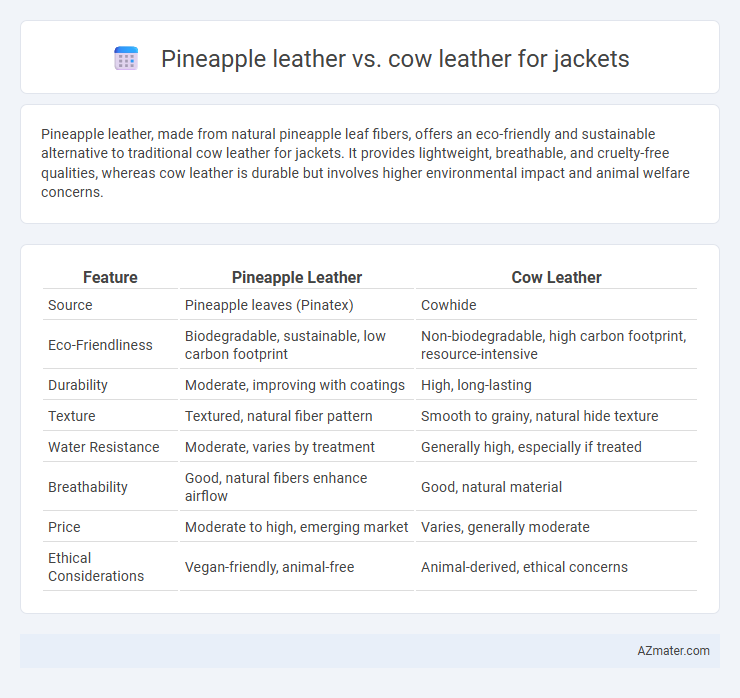Pineapple leather, made from natural pineapple leaf fibers, offers an eco-friendly and sustainable alternative to traditional cow leather for jackets. It provides lightweight, breathable, and cruelty-free qualities, whereas cow leather is durable but involves higher environmental impact and animal welfare concerns.
Table of Comparison
| Feature | Pineapple Leather | Cow Leather |
|---|---|---|
| Source | Pineapple leaves (Pinatex) | Cowhide |
| Eco-Friendliness | Biodegradable, sustainable, low carbon footprint | Non-biodegradable, high carbon footprint, resource-intensive |
| Durability | Moderate, improving with coatings | High, long-lasting |
| Texture | Textured, natural fiber pattern | Smooth to grainy, natural hide texture |
| Water Resistance | Moderate, varies by treatment | Generally high, especially if treated |
| Breathability | Good, natural fibers enhance airflow | Good, natural material |
| Price | Moderate to high, emerging market | Varies, generally moderate |
| Ethical Considerations | Vegan-friendly, animal-free | Animal-derived, ethical concerns |
Introduction to Pineapple Leather and Cow Leather
Pineapple leather, also known as Pinatex, is an innovative sustainable material derived from pineapple leaf fibers, offering an eco-friendly alternative to traditional leather. Cow leather, sourced from bovine hides, is prized for its durability, flexibility, and natural grain, making it a longstanding choice for jackets. While pineapple leather emphasizes renewable resources and reduced environmental impact, cow leather is valued for its classic texture and long-lasting quality.
Production Processes Compared
Pineapple leather, made from natural pineapple leaf fibers through a complex process of drying, milling, and bonding with bio-based resins, offers an eco-friendly alternative to traditional cow leather production, which involves energy-intensive animal farming, tanning with hazardous chemicals, and significant water consumption. The pineapple leather process reduces waste by utilizing agricultural byproducts, while cow leather relies on raising livestock, contributing to higher greenhouse gas emissions and deforestation. These contrasting production methods highlight pineapple leather's sustainable innovation versus cow leather's environmental footprint in jacket manufacturing.
Environmental Impact Analysis
Pineapple leather, derived from renewable pineapple leaves, offers a sustainable alternative to traditional cow leather by significantly reducing deforestation, water consumption, and greenhouse gas emissions linked to cattle farming. Cow leather production involves intensive resource use, including large quantities of water, land, and chemicals for tanning, contributing substantially to environmental degradation and pollution. Opting for pineapple leather jackets supports eco-friendly fashion by minimizing ecological footprints and promoting agricultural waste valorization.
Durability and Longevity
Pineapple leather, made from Pinatex, offers moderate durability suitable for casual jackets but tends to wear faster under heavy use compared to cow leather. Cow leather, known for its high strength and natural resistance to abrasion, provides superior longevity, often lasting decades with proper care. The choice between pineapple and cow leather jackets depends on the balance between eco-friendliness and long-term durability requirements.
Comfort and Wearability
Pineapple leather, made from natural Pinatex fibers, offers superior breathability and lightweight comfort compared to traditional cow leather. Cow leather provides durability and molds to the wearer's body over time, enhancing comfort through a broken-in feel. For wearability, pineapple leather's flexibility and moisture-wicking properties make it ideal for warmer climates, while cow leather excels in cold weather with its insulating qualities.
Visual Appearance and Texture
Pineapple leather offers a unique, textured surface with a natural grain that mimics traditional leather while showcasing subtle variations in pattern, lending jackets a distinctive, eco-friendly aesthetic. Cow leather features a smoother, more uniform texture with a classic, polished finish that ages gracefully, developing a rich patina over time. Visual appearance in pineapple leather tends to be matte and slightly fibrous, contrasting with the glossy, supple feel of cow leather jackets.
Cost and Accessibility
Pineapple leather, also known as Pinatex, generally costs more than cow leather due to its innovative, sustainable production methods and limited manufacturing scale. Cow leather remains more accessible and affordable, benefiting from established supply chains and mass production worldwide. The higher price of pineapple leather reflects its eco-friendly appeal and niche market demand compared to the widely available traditional cowhide jackets.
Maintenance and Care Requirements
Pineapple leather requires minimal maintenance, needing only occasional wiping with a damp cloth and avoiding prolonged exposure to direct sunlight to prevent fading. Cow leather demands regular conditioning with specialized leather care products to maintain its suppleness and prevent cracking over time. Both materials benefit from proper storage in a cool, dry place, but cow leather jackets often need more frequent treatment to retain their durability and aesthetic appeal.
Ethical and Sustainability Considerations
Pineapple leather, derived from pineapple leaf fibers, offers a sustainable alternative to traditional cow leather by utilizing agricultural waste and reducing reliance on animal farming, which lowers greenhouse gas emissions and land use. Cow leather production involves intensive water consumption, deforestation, and ethical concerns related to animal welfare, making it less environmentally friendly. Brands seeking eco-conscious and cruelty-free fashion increasingly prefer pineapple leather for jackets, aligning with consumer demand for sustainable and ethical materials.
Final Verdict: Which Leather is Best for Jackets?
Pineapple leather, made from sustainable Pinatex fibers, offers a cruelty-free and eco-friendly alternative to traditional cow leather, emphasizing biodegradability and lower carbon footprint. Cow leather remains favored for its durability, natural breathability, and classic appearance, often providing better longevity for jackets. The final verdict depends on priorities: choose pineapple leather for vegan, sustainable fashion and cow leather for long-lasting performance and traditional luxury.

Infographic: Pineapple leather vs Cow leather for Jacket
 azmater.com
azmater.com